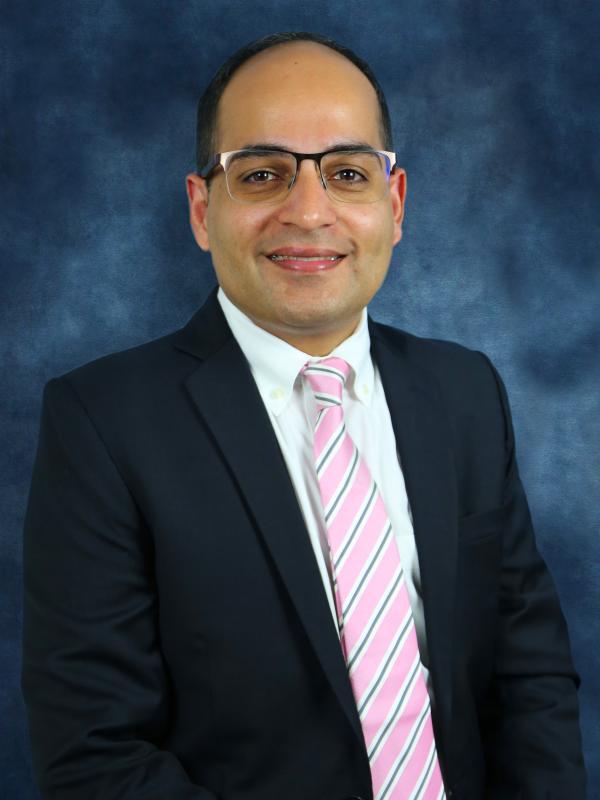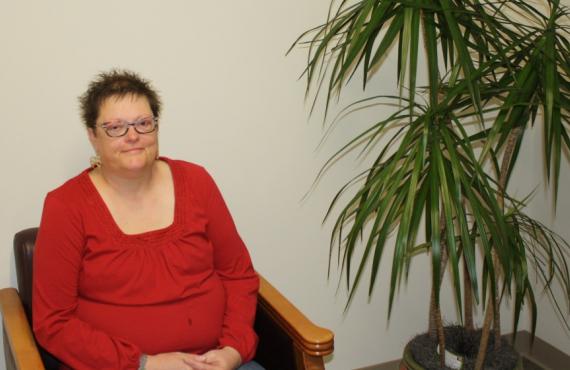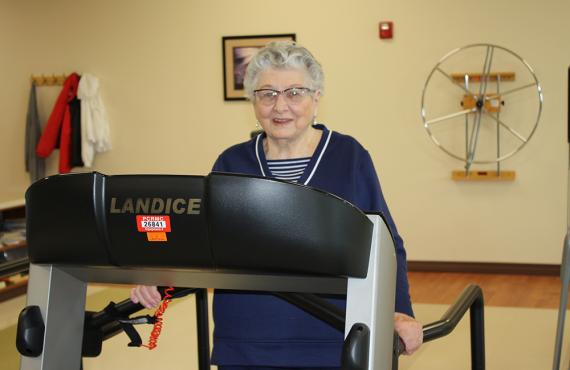Published on January 21, 2022
Read Time: 14 Minutes
Paige Heitman, director of marketing at Phelps Health, talks with Fawad Virk, MD, FACC, a board-certified cardiologist and interventional cardiologist at Phelps Health, on the Ask the Professionals radio show.
Paige: Today, we have one of our providers on our Ask the Professionals program, Dr. Virk, who is a cardiologist, specializing in interventional cardiology at Phelps Health. Welcome to our show today.
Dr. Virk: Good morning. Thank you.
Paige: We're really excited to have you here. Tell us a little bit about yourself, your practice [and] what brought you to Rolla.

Dr. Virk: As you mentioned, my name is Dr. Fawad Virk, and I did my medical [training] at a college in Pakistan. Then, I came to the United States. I did my residency in Henry Ford Hospital in Detroit, Michigan. From there, I decided to pursue cardiology [as my specialty], and I went for my cardiology fellowship at the University of Texas Medical Branch in Galveston, Texas. [Additionally,] I did one year of cardiology [fellowship at University of Texas at San Antonio] that specifically included interventional cardiology, which is my specialty now. Once I graduated from there, I decided to come to Rolla here and joined Phelps Health. It has been great so far. I love Rolla. We [my family and I] are having fun.
Paige: I love that. That's awesome. We hope that we get to keep you for a really long time here.
Dr. Virk: Absolutely.
Paige: One of the things that I love to do with our providers on this show is just tell us a little bit about your favorite interest outside of Phelps Health. Help us get to know who you are, Dr. Virk.
Dr. Virk: Apart from having a 4-year-old, I enjoy outdoor activities. We take him out, go hiking and walking, especially around the trails in Rolla. It's just really beautiful. I'm actually a TV guy, so I watch a lot of TV shows on my Netflix and HBO Max. Spending time with family, that's the most important part. That's most of what I spend my time doing if I'm not doing medicine.
Paige: Today, we're going to be talking about interventional cardiology. Just to get us kicked off, what is interventional cardiology? What does that mean?
Dr. Virk: Cardiology is obviously the whole field…but there are subspecialties within cardiology. There's a general cardiologist who does not do procedures but still sees patients, reads ultrasounds and does further testing. An interventional cardiologist specifically is the [individual] who actually goes inside your body. If somebody's having chest pain or a heart attack, they will go in and put in stents in your heart arteries -- that's specifically the intervention. You have to have extra training for that, after your three years of general cardiology [training]. We do heart cath (catheterization) procedures to check the pressures inside your heart. If you have any valve issues, [we] can go inside the heart and check your valve issues. Some of the interventional cardiologists…actually check your leg arteries [to see] if you have any blockages. They can see if they can help with that. Most of the time, an interventional cardiologist is the one who's in the cath lab. That's the main [job] of the interventional cardiologist on top of your clinic and your general cardiologist [responsibilities].
Paige: That's a lot. One of the things you mentioned that I want to talk about for a minute is you [said you had] training outside of the three years for cardiology. What type of training do interventional cardiologists need? And why is it so important for them to have that type of training?
Dr. Virk: When you do a general cardiology [training] for three years, you have to see every patient. You will deal with every part of the heart and every pathology, the heart failure, and if they [patients] have chest pains. But to put the stents in, you really need one or two [more] years. Some people do more than that, because these are not simple procedures. You need to spend more time inside the cath lab specifically for that whole year. You spend time with those patients who actually are having a heart attack or who are having chest pains. You need that one extra year to learn that specific thing, how to put in stents, how to put in mechanical heart pumps, how we can help those patients who are having a heart attack. That one-year specialized training is very important after you do general cardiology [training] and sometimes two years.
Paige: Who are the [type of] patients…going to see an interventional cardiologist?
Dr. Virk: As I said, I'm a general cardiologist on top of an interventional cardiologist. Fifty percent of my practice is seeing patients in the clinic and reading non-invasive studies. If somebody is having chest pain or having an acute heart attack, they are the ones who are actually going to see us in the cath lab. On top of that, if we do some testing, if you're having chest angina (chest pain caused by reduced blood flow to the heart), and if your stress test is abnormal, you're going to see us because we're going do that procedure called a heart cath or angiogram of your heart inside the cath lab. More specifically, somebody who is having chest pains and a heart attack, they're going to see us in the cath lab.
Paige: You mentioned chest pains. What are some of the other symptoms or conditions that somebody might come and see you for?
Dr. Virk: On top of somebody who's having chest pains or a heart attack, we also deal with patients who have abnormal heart rhythm, less specifically atrial fibrillation. Somebody who has a history of or new congestive heart failure -- we see those patients, too. Also, somebody who has leg pains and they need further evaluation for that.
Paige: Whenever you see patients who have these types of symptoms or things going on, what type of tests do you perform or order for them?
Dr. Virk: If I see them in the clinic and they’re having chest pain, we assess their risks. We start with their stress test and echocardiogram -- that's the ultrasound of your heart. If I see them in the hospital with a more acute problem, you start right from the basics. We check their blood enzymes, or troponin, to check for the heart attack, and start from the EKG and make sure that [the patient is] not having an acute heart attack. On top of that, you order an ultrasound of the heart, and if there's a heart attack going on in there, we take them to the cath lab and do an angiogram (scan that shows bloodflow) of the heart.
Paige: Let's just go back…and talk about what is cardiovascular disease and what does that mean for all of our listeners?
Dr. Virk: Cardiovascular disease is a broad term that includes your heart and…the other arteries of your body. It includes the arteries in your neck, your brain, your legs and your veins on top of that. Overall, it's a big umbrella term. Within cardiovascular disease, obviously, the biggest problem in the United States we've been dealing with is coronary artery disease…blockages in your heart. The other aspect of cardiovascular disease is heart failure. You have rhythm issues; you have valve issues. Hypertension (high blood pressure) is a big problem in our country here, and peripheral vascular disease that includes your neck arteries and your leg arteries. Cardiovascular disease is the overall broad term for all of these things I just mentioned to you.
Paige: How prevalent is heart disease? How many people are affected by it?
Dr. Virk: I would say it is like an epidemic. It's not only in the United States; it's actually everywhere in the world. I think more than 600 million people are having problems with a cardiovascular disease. The CDC (Centers for Disease Control and Prevention) is anticipating that if we don't control our risk factors, [the number of people affected] might actually go up. One in every four deaths is actually because of cardiovascular disease. I think cardiovascular disease is actually the leading cause of mortality in our country.
Paige: One of the stats that I have to share today is that heart disease is the leading cause of death for both men and women.
Dr. Virk: I'm glad you mentioned women. They have a lot of risk factors, and sometimes we are not really good at managing heart disease in women because women present [symptoms] in a different way…compared to men. There's always data that comes out about the gender disparity and the healthcare disparities [as well as] different racial disparities between men and women. They [women] sometimes don't have chest pain. They may come in with shortness of breath, or feeling fatigued, nausea, vomiting. I think, as physicians and an overall community, we have to be very vigilant about those symptoms that some women are presenting to the hospital.
Paige: What do our doctors mean whenever they say primary or secondary [prevention] whenever we're talking about heart health?
Dr. Virk: When you say primary prevention, the goal is to prevent any disease, to prevent…cardiovascular disease. So basically, what you do in primary prevention is you take care of all those risk factors which you can to prevent having any cardiovascular event. That includes high blood pressure, diabetes, if you're a smoker, if you're overweight. You're going to take care of those risk factors before you develop cardiovascular disease. That's what we usually call it -- primary prevention, as compared to secondary prevention. That is the one when you actually have a heart attack, you actually have a cardiovascular disease. Now since you have developed the disease, you have to be more aggressive now about taking care of those risk factors that I mentioned -- cholesterol, blood pressure, diabetes. If you don't take care of that, if you don't do that secondary prevention, then you might be in trouble. Your heart disease might get worse if we don't take care of that. That's usually called secondary prevention.
Paige: Smoking -- that always seems to be a really hot topic for all of the doctors that I have on here. Why is smoking bad for your heart health and why is it just bad overall?
Dr. Virk: Smoking is a big risk factor in our community or overall in the United States. Cigarettes have a lot of toxins in them. It's not just the nicotine; it's a lot of toxins that actually promote inflammation. Anything that can cause inflammation is going to cause more problems within your heart arteries. All of those toxins [from] smoking -- and I'm not just talking about the cigarette; I'm talking about all other ways that you actually inhale, vaping or hookah -- actually promote that inflammation and can cause your cardiovascular disease on top of [raising your] risk for lung cancer and other problems.
Paige: Whenever we talk about smoking, it makes me think of nature versus nurture. There are things that we can control, like whether we're a smoker or not a smoker, but what role does our genetics play in secondary prevention or…managing cardiovascular disease?
Dr. Virk: Genetics is actually one part of the…overall cardiovascular risk factors. There have been multiple genes identified that can actually increase your risk for heart disease. So, yes, genetics play a role. Unfortunately, it's not just the genetics; it’s also your environmental factors that actually make things worse [and can cause you] to develop heart failure. If you have a family history of heart disease…specifically, if somebody, your dad, had a heart attack before 55, if your mom had a heart attack before 65 -- usually we call this premature cardiovascular disease – hypertension (high blood pressure) or hyperlipidemia (when your blood has too many fats), all those genes you have actually contribute to your risk factor. Obviously, you cannot change your genes, but you can modify your environmental effects that may contribute to cardiovascular disease. Yes, genetics play a major role.
Paige: This is a perfect segue into my next question. Family is really, really important whenever we talk about managing cardiovascular health. How can family members work together to ensure that everybody in the entire family -- not just the person who has the risk factor or is dealing with secondary prevention of cardiovascular disease -- how can they work together to create a really healthy lifestyle and environment?
Dr. Virk: If somebody had a heart attack, it's a big change in their life. They need a lot of help. We put in a stent. We say, "OK, let's go home, you're doing fine." But they [patients] need a lot of social [help and] they need a lot of emotional help from the family. Family is the one that can encourage them and motivate them to eat healthy, exercise, whatever they can tolerate, and take care of themselves. If they're a smoker, they can actually encourage them not to smoke. A lot of patients have these issues too, because they [experience] secondhand smoking. If their spouse, if their other family member is smoking, it's hard for them to quit. Everything starts from home. Family plays a major role [in taking] care of those secondary prevention [of reducing risk factors] in terms of their diet, smoking, high blood pressure…and their exercise. I think without family support, it gets pretty tough, because the patient is already in a lot of stress because of the heart attack. I have seen a lot of patients…at Phelps Health, and I feel like there is very good family support here. The family system is actually really good and they have a lot of help from their family. I'm really glad about that.
Paige: Whenever you talk about patients who are older, [for example] my grandparents, whenever they do remember to take their medication, what's different for them is their lifestyle and their diet is not up to par. They may take their medicine, but then they'll go eat fried eggs. How important is diet and lifestyle modifications? Sometimes we think about diet and that has a negative connotation. What type of diet would you recommend, or is it just watching…portions?
Dr. Virk: Both, I would say…I usually take a more realistic approach, I can't just tell you to stop eating. We have to live, and we have to eat. The important thing is to eat healthy. What that means is, please make sure that you include more fruits and vegetables in your diet. If you like chicken, eat chicken. If you like red meat, you can eat red meat. I'm not telling you to stop everything, but try to eat a leaner or less fatty portion. Add vegetables, fruits, nuts, legumes [and] beans in your diet with that. Fruits and vegetables, as I mentioned, have anti-inflammatory effects on your heart and that's how they help with that. All those antioxidants in your food help with that, and some foods actually promote inflammation. For heart disease overall, watch your salt, watch your sugar. Try to avoid a lot of sugar you're putting in your coffee. You can drink a coffee with less sugar or no sugar. A lot canned food which you're eating has a lot of salt in it. They have to put salt in there to preserve that food, which you may not know. Usually patients say, “No, I just put a small amount of salt [on my food].” I ask, “Do you eat out?” [The patients answer,] “Yeah, I do. I pick up fast food from here or there.” You are not aware of that. There's a lot of salt in fast food; they have to preserve the food with salts.
Paige: Well, even in our packaged meats that are uncooked, they have salt in it and we don't realize that.
Dr. Virk: Try to eat at home. [Eat] fresh food, more vegetables and more fruits. That definitely helps, and on top of that, exercise.
Paige: Dr. Virk, I think that's amazing. What a great way to wrap up our show. Thank you so much for being here today.
Learn More
You can listen to Dr. Virk and Paige Heitman on the Ask the Professionals radio show.

